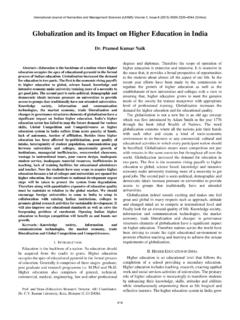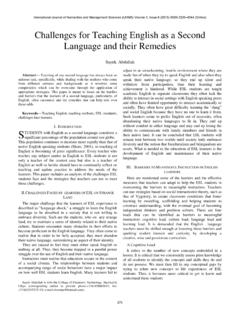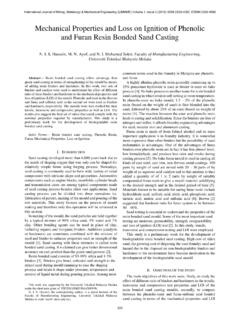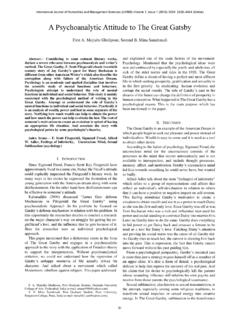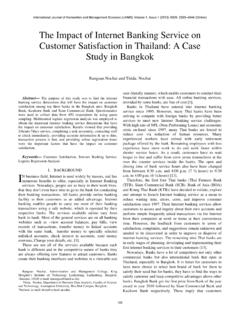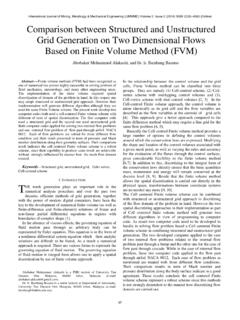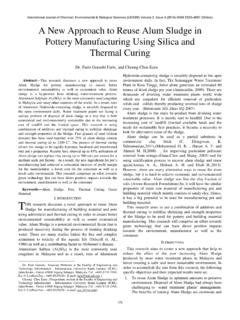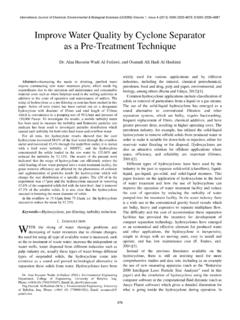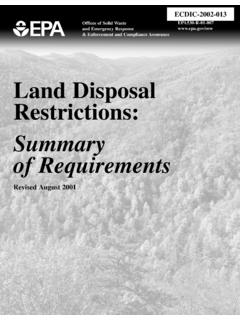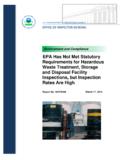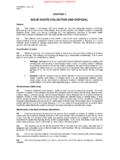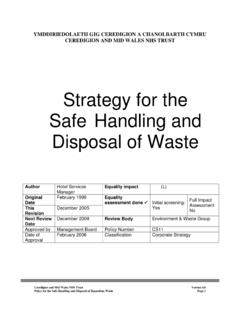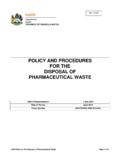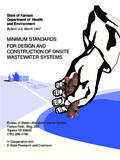Transcription of A Discussion on Waste Generation and …
1 Abstract This paper, a continuation and expansion of the work of Muzenda et al, 2012 [1] looks at the management trends in South Africa. It focuses on Waste classification, hierarchy, Generation and management. The Waste tyre problem in South Africa is also briefly discussed. Solid Waste management is a growing environmental problem in developing countries such as South Africa. The increasing standard of living and economic growth results in challenges in the management of both general and hazardous Waste . Landfill sites life spans have been reduced and hence the need for Waste minimization, utilization and alternative disposal methods.
2 Waste tyre management is challenge as they are non compactable and non-biodegradable. The REDISA Integrated Industry Waste Tyre Management Plan (IIWTMP) approved by Environmental Affairs Minister, Edna Molewa, and published in the Government Gazette [No. 35927] in November 2012 support and promote tyre recycling, providing the collection and depot infrastructure required to collect Waste tyres from across the entire country and deliver them to approved recyclers. The objectives of this paper were achieved through a literature review and analysis.
3 Keywords Environmental, Recycling, REDISA, Waste Hierarchy, Waste Management I. INTRODUCTION N generic terms, Waste can be defined as an unavoidable by-product of most human activity . Economic development and rising living standards have increased in the quantity and complexity of generated Waste . Moreover, industrial diversification and the provision of expanded health-care facilities have added substantial quantities of industrial hazardous Waste and biomedical Waste into the Waste stream with potentially severe environmental and human health consequences.
4 There are two fundamental Waste classes, namely, general Waste (municipal Waste ) and hazardous Waste (health care risk Waste and certain industrial Waste ). Waste tyres fall under the general Waste category which gives rise to land filling, health and environmental challenges. Waste tyres can be characterised as polymers which are non-biodegradable because of their complex mixture consisting of several rubbers, carbon black, steel cord and other organic and inorganic components. In South Africa, it is estimated that around 60 million legacy E. Muzenda is is a Professor of Chemical Engineering, Department of Chemical of Chemical Engineering as well as part-time Energy and Environmental Engineering Specialist and Consultant at the Process, Energy and Environmental Technology Station, Faculty of Engineering and the Built Environment, University of Johannesburg, Doornfontein, Johannesburg 2028, Tel: +27115596817, Fax: +27115596430, (Email: Waste tyres are lying in dumps and stockpiles or scattered across the country in residential, industrial and rural areas.)
5 In addition, almost 11 million Waste tyres are added to this number every year. The disposal of Waste tyres is a growing environmental problem for the modern society, especially in developing countries. The major concerns are (i) tyre stockpiles provide breeding ground for mosquitoes and vermin, this in turn, causes serious diseases, thus affecting human health, (ii) fire hazards in large stockpiles that could consequently cause uncontrollable burning and air pollution, (iii) the current conservation of natural resource concept , precisely, the reuse (retread) first, then reuse of rubber prior disposal , does not accommodate the ever increasing dumping of tyres, (iv)
6 Due to the high cost of legal disposal for tyres, illegal dumping may increase, (v) disposal of tyres is becoming more expensive, while this trend is likely to continue as landfill space becomes more scarce. Tyres require large quantities of air space because their volume and non compactability [2]. Through the REDISA Waste Tyre Management Plan, tyres will now be recycled into useful products instead of polluting the environment. Different recycling processes are being practiced such as reclaiming, incineration, retreading, grinding etc.
7 But these have weaknesses and drawbacks [3]. II. CLASSIFICATION OF Waste A. Waste Classes Waste classification systems are vastly documented in South Africa; these include Waste regulations and laws such as the minimum requirements for the handling, classification and disposal of general and hazardous Waste [4] as well as the Waste classification and management regulations, which is in accordance with the Waste Act (Act No. 59, 2008) [5]. Some of the laws that have been amended on this act include, Act No. 73 of 1989 (Environmental Conservation Act, 1989) whereby certain sections have been amended or repealed as well as the repulsion of sections 8 and 9 of the environmental conservation amendment Act, 1992 (Act No.)
8 79 of 1992). The Waste classification system is based on the concept of risk [4]. It is accepted that there is no Waste that is truly "non-hazardous", since nothing is entirely safe or ideally non-hazardous. No matter how remote the risk posed to man and the environment by a particular Waste , it nonetheless exists. However, it is possible to assess the severity of the risk, and to make informed decisions on that basis. The classification system therefore distinguishes between Waste of extreme A Discussion on Waste Generation and Management Trends in South Africa Edison Muzenda I International Journal of Chemical, Environmental & Biological Sciences (IJCEBS) Volume 2, Issue 2 (2014) ISSN 2320 4087 (Online)105hazard, which requires the utmost precaution during disposal , and Waste of limited risk, requiring less attention during disposal .
9 Thus Waste is divided into two main classes, namely general and hazardous Waste , which are further sub classified into smaller categories. General Waste is sub classified into domestic, industrial and institutional Waste , while hazardous Waste class is further classified into explosives, flammable liquids and solids as well as corrosives. The Waste classification system is in accordance with the risk Waste poses, hence, general Waste poses little risk to the environment while hazardous Waste poses significant risk. For Waste to be properly managed, its properties and its risk potential must be fully understood.
10 - General Waste General Waste does not pose a significant threat to public health or the environment if properly managed [4]. Examples would include domestic, commercial, certain industrial wastes and builder's rubble. General Waste may be disposed of at any duly authorized Waste disposal facility permitted in terms of the Environment Conservation Act (73 of 1989). Domestic Waste is classified as general Waste even though it may contain hazardous components. This is because the quantities and qualities of hazardous substances in domestic Waste are sufficiently minor to be a potential risk.
